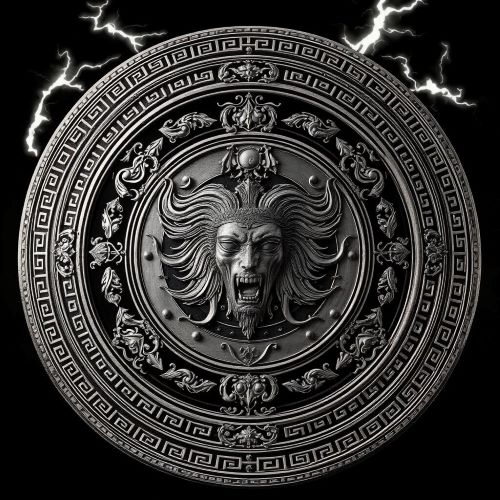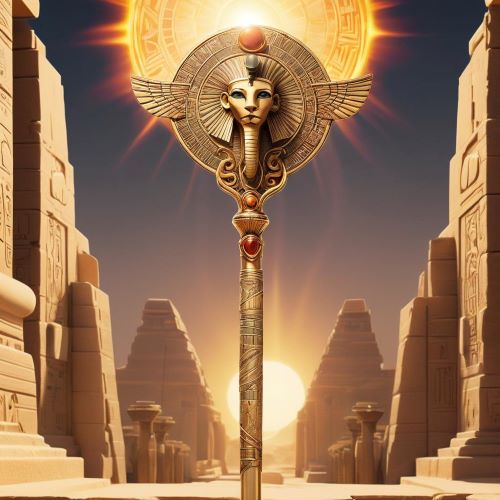Svalinn : The Solar Shield
Svalinn
Introduction
In the mythology of the Norse people, weapons and objects are never just tools; they carry cosmic weight, shaping the balance of the universe itself. While most legendary items such as Thor’s hammer Mjölnir or Odin’s spear Gungnir are linked with battle and conquest, Svalinn stands out as something far more passive yet equally vital. It is not a weapon of aggression but a shield of preservation. Svalinn’s sole purpose is to protect the world from the overwhelming heat of the sun. Without it, seas would boil, mountains would burn, and life could not survive. Unlike other mythic artifacts, it is not meant for a hero’s hand but for the order of the cosmos, symbolizing the fine line between life-giving warmth and destructive fire.
Origins
The name Svalinn comes from Old Norse, meaning “cool” or “chill,” derived from the verb svala, “to cool.” Its very name captures its function: a force of cooling, tempering, and shielding. The first mention of Svalinn appears in Grímnismál, a poem preserved in the Poetic Edda, where Odin describes its cosmological role. He explains that Svalinn stands in front of the sun, ensuring that its flames do not engulf the world:
“Svalinn is his name, he stands before the sun,
a shield for the shining god;
mountains and sea would burn, I know,
if he fell from before.” (Grímnismál, stanza 38)
This passage makes it clear that Svalinn is not a battlefield shield but a cosmic barrier. Its origin can be connected with earlier Nordic traditions. During the Nordic Bronze Age, the sun was often depicted as a disc or chariot wheel, as seen in artifacts like the Trundholm Sun Chariot. Scholars suggest that over time, the image of the glowing sun disk may have merged with the shape of a shield, giving rise to the myth of Svalinn as a great cosmic shield. Ritual shields found from this era, decorated with sun-like motifs, further reinforce this theory.
Think you know your myths and legends? Dive into the world of ancient stories and test your knowledge with our engaging quizzes on Mythlok!
Powers
Svalinn’s powers lie not in combat but in its unmatched protective strength. Its primary ability is to shield the earth from the sun’s blazing heat, preventing catastrophe. If Svalinn were to fall, Odin himself warns that both mountains and seas would be set aflame. Unlike Mjölnir or other divine weapons that demonstrate their powers in moments of conflict, Svalinn’s strength is constant, working every day and night to keep balance in the cosmos.
Some later traditions also describe Svalinn as being inscribed with runes, adding a layer of magical force to its already immense natural role. In Sigrdrífumál, a Valkyrie speaks of runes carved on shields, and though Svalinn is not directly tied to these specific inscriptions, the connection suggests that divine symbols may have enhanced its protective capacity. Scholars often liken it to the Greek Aegis, but unlike Zeus’s shield, which is summoned in battle, Svalinn is unceasing in its service, representing eternal vigilance.
Modern retellings often expand upon its abilities. In fantasy literature and role-playing games, Svalinn is sometimes imagined as indestructible, capable of making its wielder invulnerable, or even granting resistance to magical attacks. In these interpretations, Svalinn transforms from a cosmic necessity into a heroic relic, though always retaining its identity as a supreme symbol of protection.
Owners/Users
Unlike most mythological weapons and shields, Svalinn does not belong to a single god or hero. It is not carried into war but instead forms part of the solar system itself. The gods of the Aesir are credited with placing it before the sun’s chariot, which is driven by the goddess Sól. Her horses, Árvakr and Alsviðr, draw the burning sun across the heavens, but without Svalinn, their journey would destroy everything in its path.
In Grímnismál, Odin is the one who explains its existence, which has led some interpreters to connect him closely to Svalinn. However, the shield functions as a communal divine safeguard rather than personal property. It belongs not to an individual deity but to the order of the cosmos, much like the roots of Yggdrasil or the flow of fate spun by the Norns.
In modern times, the name Svalinn has been adopted in contexts where protection and vigilance are emphasized. For instance, Svalinn is the name of a company that breeds and trains protection dogs, drawing on the shield’s symbolism as a guardian. While this has no direct link to Norse myth, it shows how enduring the name is as a metaphor for safety and watchfulness.
Instances used
The mythological role of Svalinn is not one of dramatic appearances in heroic sagas but of quiet, eternal presence. Its most detailed description is found in Grímnismál, where Odin explains its function as a shield before the sun. The Prose Edda’s Nafnaþulur section also includes Svalinn in a list of shields, showing that it was remembered among the great legendary armaments. Additionally, Sigrdrífumál’s references to runes on shields, while not directly naming Svalinn, may imply that such divine shields were seen as magically fortified.
In modern adaptations, Svalinn’s role has been expanded to suit different creative needs. In video games such as Northgard, a relic called Svalinn grants extra defense to armies and counters negative effects, echoing its mythological role as a buffer against destruction. Role-playing games sometimes depict it as an indestructible artifact, capable of absorbing damage or granting powerful regeneration abilities. Even Marvel’s Thor franchise has occasionally drawn inspiration from Norse mythological shields like Svalinn when portraying Odin’s armory of cosmic relics.
These reinterpretations highlight how Svalinn continues to inspire creators. While it began as a poetic symbol of cosmic balance, it now appears in popular culture as a tangible object of immense protective power.
Frequently Asked Questions
Lorem ipsum dolor sit amet, consectetur adipiscing?
Lorem ipsum dolor sit amet, consectetur adipiscing elit. Praesent convallis vestibulum justo, ac tincidunt nunc vehicula quis. Nullam id dolor quis orci malesuada feugiat. Curabitur aliquet libero at urna ullamcorper, ac ultricies nulla dapibus.
Lorem ipsum dolor sit amet, consectetur adipiscing?
Lorem ipsum dolor sit amet, consectetur adipiscing elit. Praesent convallis vestibulum justo, ac tincidunt nunc vehicula quis. Nullam id dolor quis orci malesuada feugiat. Curabitur aliquet libero at urna ullamcorper, ac ultricies nulla dapibus.
Lorem ipsum dolor sit amet, consectetur adipiscing?
Lorem ipsum dolor sit amet, consectetur adipiscing elit. Praesent convallis vestibulum justo, ac tincidunt nunc vehicula quis. Nullam id dolor quis orci malesuada feugiat. Curabitur aliquet libero at urna ullamcorper, ac ultricies nulla dapibus.
Lorem ipsum dolor sit amet, consectetur adipiscing?
Lorem ipsum dolor sit amet, consectetur adipiscing elit. Praesent convallis vestibulum justo, ac tincidunt nunc vehicula quis. Nullam id dolor quis orci malesuada feugiat. Curabitur aliquet libero at urna ullamcorper, ac ultricies nulla dapibus.
Lorem ipsum dolor sit amet, consectetur adipiscing?
Lorem ipsum dolor sit amet, consectetur adipiscing elit. Praesent convallis vestibulum justo, ac tincidunt nunc vehicula quis. Nullam id dolor quis orci malesuada feugiat. Curabitur aliquet libero at urna ullamcorper, ac ultricies nulla dapibus.
Watch
Source
Orchard, A. (1997). The Poetic Edda. Oxford University Press.
Lindow, J. (2001). Norse Mythology: A Guide to Gods, Heroes, Rituals, and Beliefs. Oxford University Press.
Sturluson, S. (1995). The Prose Edda (Translated by Jesse Byock). Penguin Classics.
Wikipedia contributors. (2024). Svalinn. Wikipedia. https://en.wikipedia.org/wiki/Svalinn
Williamson, J. (2024). Svalinn: The Legendary Shield of Nordic Mythology. The Viking Herald. https://thevikingherald.com/article/svalinn-the-legendary-shield-of-nordic-mythology/893
Ulfberth. (2024). Shields in myths: From Aegis to Svalinn – Battle-Merchant. https://www.battlemerchant.com/en/blog/shields-in-myths-from-aegis-to-svalinn









